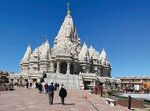


My husband and I drove to New Jersey and found ourselves in India. The real journey began there in Robbinsville, a little town not far from Trenton.
What we sought suddenly stood before us — the BAPS Swaminarayan Akshardham — 13 years in the making.
In no way was I prepared for the enormity and exotic beauty of this new center of Hindu worship so close to home; nor did I expect the sense of peace and holiness that radiates from the white marble interior of the mandir (temple.)
My husband and I found there not just a sense of amazement at the fabulous architecture but also the timeless wisdom of Hinduism, a profound sense of unconditional love, inner peace and selfless service — so lacking in today’s divided and angry society.
With the help of our guide, Sid Dubal, we soon found ourselves caught up in the ancient culture of Hinduism, the oldest and most complex of belief systems. BAPS, he told us is a sect of Hinduism, mostly rooted in western India.
“Why Robbinsville?” I asked Sid.
“Because of the high concentration of Hindus in the region,” he said, plus easy access from major transportation routes.
About 1 million Hindus live in New York, New Jersey, Connecticut and Pennsylvania.
Akshardham, built according to early Hindu scriptures, includes one main shrine and 12 sub-shrines. Featured are an incredible 10,000 statues and statuettes. Pillars, arches and ceilings are covered with elaborate carvings of ancient musical instruments, dance forms and animals, mostly elephants and peacocks beloved by Hindus.
The flat-topped outer buildings are a perfect setting for the gleaming, chalk-white mandir which reaches for the sky. It is covered with carvings inside and out. Nearly 2 million cubic feet of stone — mainly marble, granite, limestone and sandstone — and others from all over the world were carved and assembled in India. Individual pieces were numbered and shipped to Robbinsville where they were reassembled, according to Sid.
A 49-foot-tall bronze statue (murti, or sacred image) of a boy, Nilkanth Varni, in a yoga tree position, dominates the entrance to the 183-acre campus and soars high above the plaza bearing his name, which leads to the main mandir.
The boy is a younger form of the swami (teacher or monk) named Bhagwan Swaminarayan, to whom the campus is dedicated. It honors the teenager’s seven-year, 8,000-mile journey on foot across India two centuries ago, Sid told us.
Just beyond the statue is Brahma Kund, a traditional Indian stepwell, containing waters from more than 300 places, including India’s holy rivers and all 50 states. In ancient India, Sid said, people thought of stepwells as inverted mandirs and would climb down the steps into the water to pray.
The complex, dedicated last August, was built between 2011 and 2023. About 12,500 artisans and workers devoted about 4.7 million volunteer hours to the complex. Parts of it are still under construction. We walked for three hours and still did not see everything. In two sacred places we had to remove our shoes.
We watched the midday arti ceremony in the mandir. In an ancient Hindu offering, swamis, accompanied by music, waved lighted incense sticks before the sacred images. Sid said it memorializes the early days of the religion when the worshippers met in dark caves.
“People think we have many gods but we are monotheistic and these are just different forms of God,” he said.
Before we left we also took part in an individual religious ritual. Given a cup of water, we poured it gently over a murti as we said a prayer. It felt absolutely right to pray in a place so full of symbolism — some of it so familiar to a Christian — the water, the lights, the incense, the music, the love and reverence for the one who created all of us.
The site, open daily except Tuesday, also features a welcome center, a bookstore/candy shop, a vegetarian cafe, a research institute, a museum (not yet open), and an event center. In just eight months it has become a religious tourist destination for Hindus around the world, and is so popular that weekend visitors must now preregister.
Kathryn Finegan Clark is a freelance writer who lives in Durham Township. She can be reached at kathyclark817@gmail.com.
Join our readers whose generous donations are making it possible for you to read our news coverage. Help keep local journalism alive and our community strong. Donate today.